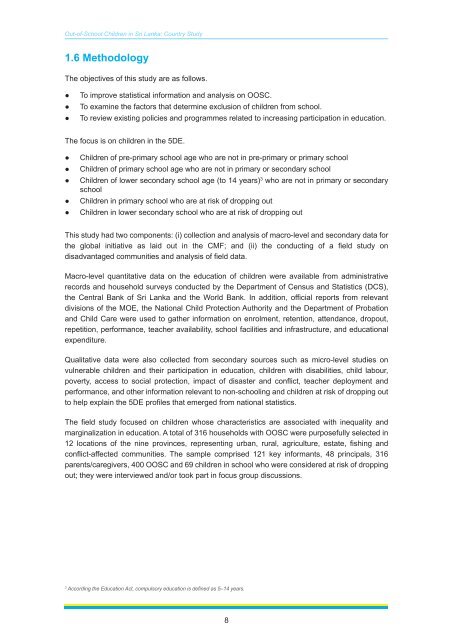Sri Lanka - Institut de statistique de l'Unesco
Sri Lanka - Institut de statistique de l'Unesco
Sri Lanka - Institut de statistique de l'Unesco
Create successful ePaper yourself
Turn your PDF publications into a flip-book with our unique Google optimized e-Paper software.
Out-of-School Children in <strong>Sri</strong> <strong>Lanka</strong>: Country Study<br />
1.6 Methodology<br />
The objectives of this study are as follows.<br />
●<br />
●<br />
●<br />
To improve statistical information and analysis on OOSC.<br />
To examine the factors that <strong>de</strong>termine exclusion of children from school.<br />
To review existing policies and programmes related to increasing participation in education.<br />
The focus is on children in the 5DE.<br />
●<br />
●<br />
●<br />
●<br />
●<br />
Children of pre-primary school age who are not in pre-primary or primary school<br />
Children of primary school age who are not in primary or secondary school<br />
Children of lower secondary school age (to 14 years) 3 who are not in primary or secondary<br />
school<br />
Children in primary school who are at risk of dropping out<br />
Children in lower secondary school who are at risk of dropping out<br />
This study had two components: (i) collection and analysis of macro-level and secondary data for<br />
the global initiative as laid out in the CMF; and (ii) the conducting of a field study on<br />
disadvantaged communities and analysis of field data.<br />
Macro-level quantitative data on the education of children were available from administrative<br />
records and household surveys conducted by the Department of Census and Statistics (DCS),<br />
the Central Bank of <strong>Sri</strong> <strong>Lanka</strong> and the World Bank. In addition, official reports from relevant<br />
divisions of the MOE, the National Child Protection Authority and the Department of Probation<br />
and Child Care were used to gather information on enrolment, retention, attendance, dropout,<br />
repetition, performance, teacher availability, school facilities and infrastructure, and educational<br />
expenditure.<br />
Qualitative data were also collected from secondary sources such as micro-level studies on<br />
vulnerable children and their participation in education, children with disabilities, child labour,<br />
poverty, access to social protection, impact of disaster and conflict, teacher <strong>de</strong>ployment and<br />
performance, and other information relevant to non-schooling and children at risk of dropping out<br />
to help explain the 5DE profiles that emerged from national statistics.<br />
The field study focused on children whose characteristics are associated with inequality and<br />
marginalization in education. A total of 316 households with OOSC were purposefully selected in<br />
12 locations of the nine provinces, representing urban, rural, agriculture, estate, fishing and<br />
conflict-affected communities. The sample comprised 121 key informants, 48 principals, 316<br />
parents/caregivers, 400 OOSC and 69 children in school who were consi<strong>de</strong>red at risk of dropping<br />
out; they were interviewed and/or took part in focus group discussions.<br />
3<br />
According the Education Act, compulsory education is <strong>de</strong>fined as 5–14 years.<br />
8

















